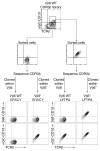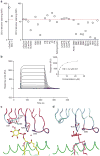A molecular basis for NKT cell recognition of CD1d-self-antigen
- PMID: 21376640
- PMCID: PMC3070541
- DOI: 10.1016/j.immuni.2011.01.013
A molecular basis for NKT cell recognition of CD1d-self-antigen
Abstract
The antigen receptor for natural killer T cells (NKT TCR) binds CD1d-restricted microbial and self-lipid antigens, although the molecular basis of self-CD1d recognition is unclear. Here, we have characterized NKT TCR recognition of CD1d molecules loaded with natural self-antigens (Ags) and report the 2.3 Å resolution structure of an autoreactive NKT TCR-phosphatidylinositol-CD1d complex. NKT TCR recognition of self- and foreign antigens was underpinned by a similar mode of germline-encoded recognition of CD1d. However, NKT TCR autoreactivity is mediated by unique sequences within the non-germline-encoded CDR3β loop encoding for a hydrophobic motif that promotes self-association with CD1d. Accordingly, NKT cell autoreactivity may arise from the inherent affinity of the interaction between CD1d and the NKT TCR, resulting in the recognition of a broad range of CD1d-restricted self-antigens. This demonstrates that multiple self-antigens can be recognized in a similar manner by autoreactive NKT TCRs.
Copyright © 2011 Elsevier Inc. All rights reserved.
Figures







Comment in
-
The immutable recognition of CD1d.Immunity. 2011 Mar 25;34(3):281-3. doi: 10.1016/j.immuni.2011.03.006. Immunity. 2011. PMID: 21435579
Similar articles
-
Human and mouse type I natural killer T cell antigen receptors exhibit different fine specificities for CD1d-antigen complex.J Biol Chem. 2012 Nov 9;287(46):39139-48. doi: 10.1074/jbc.M112.412320. Epub 2012 Sep 20. J Biol Chem. 2012. PMID: 22995911 Free PMC article.
-
Vβ2 natural killer T cell antigen receptor-mediated recognition of CD1d-glycolipid antigen.Proc Natl Acad Sci U S A. 2011 Nov 22;108(47):19007-12. doi: 10.1073/pnas.1109066108. Epub 2011 Nov 7. Proc Natl Acad Sci U S A. 2011. PMID: 22065767 Free PMC article.
-
The Role of Adaptor Proteins in the Biology of Natural Killer T (NKT) Cells.Front Immunol. 2019 Jun 25;10:1449. doi: 10.3389/fimmu.2019.01449. eCollection 2019. Front Immunol. 2019. PMID: 31293596 Free PMC article. Review.
-
Atypical natural killer T-cell receptor recognition of CD1d-lipid antigens.Nat Commun. 2016 Feb 15;7:10570. doi: 10.1038/ncomms10570. Nat Commun. 2016. PMID: 26875526 Free PMC article.
-
Recognition of CD1d-restricted antigens by natural killer T cells.Nat Rev Immunol. 2012 Dec;12(12):845-57. doi: 10.1038/nri3328. Epub 2012 Nov 16. Nat Rev Immunol. 2012. PMID: 23154222 Free PMC article. Review.
Cited by
-
Natural Killer T Cells: An Ecological Evolutionary Developmental Biology Perspective.Front Immunol. 2017 Dec 22;8:1858. doi: 10.3389/fimmu.2017.01858. eCollection 2017. Front Immunol. 2017. PMID: 29312339 Free PMC article. Review.
-
Invariant Natural Killer T Cell Subsets-More Than Just Developmental Intermediates.Front Immunol. 2018 Jun 20;9:1393. doi: 10.3389/fimmu.2018.01393. eCollection 2018. Front Immunol. 2018. PMID: 29973936 Free PMC article. Review.
-
Natural Killer T Lymphocytes Integrate Innate Sensory Information and Relay Context to Effector Immune Responses.Crit Rev Immunol. 2021;41(4):55-88. doi: 10.1615/CritRevImmunol.2021040076. Crit Rev Immunol. 2021. PMID: 35381143 Free PMC article. Review.
-
Therapeutic Targeting and Structural Characterization of a Sotorasib-Modified KRAS G12C-MHC I Complex Demonstrate the Antitumor Efficacy of Hapten-Based Strategies.Cancer Res. 2025 Jan 15;85(2):329-341. doi: 10.1158/0008-5472.CAN-24-2450. Cancer Res. 2025. PMID: 39656104 Free PMC article.
-
The versatility of the αβ T-cell antigen receptor.Protein Sci. 2014 Mar;23(3):260-72. doi: 10.1002/pro.2412. Epub 2014 Jan 28. Protein Sci. 2014. PMID: 24375592 Free PMC article. Review.
References
-
- Arden B, Clark SP, Kabelitz D, Mak TW. Mouse T-cell receptor variable gene segment families. Immunogenetics. 1995;42:501–530. - PubMed
-
- Bendelac A, Savage PB, Teyton L. The Biology of NKT Cells. Annu Rev Immunol. 2007;25:297–336. - PubMed
-
- Borg NA, Wun KS, Kjer-Nielsen L, Wilce MC, Pellicci DG, Koh R, Besra GS, Bharadwaj M, Godfrey DI, McCluskey J, Rossjohn J. CD1d-lipid-antigen recognition by the semi-invariant NKT T-cell receptor. Nature. 2007;448:44–49. - PubMed
-
- Brigl M, Brenner MB. How invariant natural killer T cells respond to infection by recognizing microbial or endogenous lipid antigens. Sem Immunol. 2009;22:79–86. - PubMed
Publication types
MeSH terms
Substances
Associated data
- Actions
- Actions
Grants and funding
LinkOut - more resources
Full Text Sources
Other Literature Sources
Molecular Biology Databases

